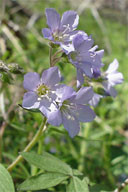 Loading... Please wait...
Loading... Please wait...- Home
- SEEDS
- SEED MIXES
- BUY PLANTS
- Info Request
-
Educational Videos
- Greenhouse Transplanting Demonstration
- Native Seed Cleaning demonstration at Ion Exchange Native Seed and Plant Nursery
- Attracting Butterflies
- Bidens - Bidens cernua Harvest Video
- Big Blue Stem Harvest
- Butterfly Milkweed Video
- Button Blazingstar - Liatris aspera Video
- Buttonbush - Cephalanthus occidentalis Video
- Canada Anemone - Anemone canadensis Harvest Video
- Cardinal Flower - Lobelia cardinalis Video
- Control Burn - Wildflower Field
- Cream Gentian - Gentiana flavida
- Culver's Root - Veronicastrum virginicum Video
- Cup Plant - Silphium perfoliatum Video
- Dormant Seeding | Planting
- Earthyman's Favorite Wildflowers Video
- Eco-Friendly Golf Course Seed Mix
- Floating Islands
- Fringed Loosestrife - Lysimachia ciliata Video
- Giant Yellow Hyssop - Agastache nepetoides Video
- Indiangrass - Sorghastrum nutans Video
- Iowa Prairie Partner Program
- Leadplant - Amorpha canescens (Potted) Video
- Meadow Blazingstar - Liatris ligulistylis
- Midland Shooting Stars - Dodecatheon meadii Video
- Native Plant Nursery Field Irrigation Experiment
- Nodding Onion - Allium cernuum Video
- Ohio spiderwort - Tradescantia ohiensis Video
- Old Man's Beard - Clematis virginiana blooms Video
- Oxeye Sunflower - Heliopsis helianthoides Video
- Prairie Spiderwort - Tradescantia bracteata
- Purple Coneflower - Echinacea purpurea Video
- Rain Garden or Water Garden Video
- Rattlesnake Master - Eryngium yuccifolium Video
- Riverbank Stabilization - Wetland Plants
- Rose Mallow - Hibiscus militaris Video
- Rosinweed - Silphium integrifolium Video
- Royal Catchfly - Silene regia
- Showy Tick Trefoil - Desmodium canadense Video
- Sneezeweed - Helenium autumnale Video
- Swamp Betony - Pedicularis lanceolata Video
- Swamp Milkweed - Asclepias incarnata Video
- Sweet Blackeyed Susan - Rudbeckia subtomentosa Video
- Tall Coreopsis - Coreopsis tripteris Video
- Urban Butterfly Garden
- Wild Bergamot - Monarda fistulosa Video
- Wild Geranium - Geranium maculatum Harvest
- Wild Goldenglow - Rudbeckia lanciniata Video
- Wild Petunia - Ruellia humilis Harvest Video
- Woodland Knotweed - Polygonum virginianum Video
- Yellow Coneflower - Ratibida pinnata Video
- Blog
- Resources
- Policies
Contact Us
Phone:
563-419-0837
or 563-535-7231
Email:
hbright@ionXchange.com
Browse Products
Add to Wish List
You Recently Viewed...
Our Newsletter
Product Description
"Jacob's Ladder, Bluebell, Greek Valerian, Skunk Weed"
| Sun Exposure | Prairie, Savanna, Woodland |
| Soil Moisture | Wet Mesic, Mesic, Dry Mesic |
| Bloom Time |
Spring, Summer April, May, June |
| Bloom Color | Blue |
| Max Height | 1 feet |
| Wetland Code | FAC |
| Germ Code | C(60) |
| Seeds Per Ounce | 18,000 |
Polemonium has two possible sources. The first is named in honor of the Greek philosopher, Polemon. The second is from the ancient Greek word for war, polemos. Pliny the Elder wrote of a short war that was fought over who actually discovered this plant. Reptans is a little more clear cut. It's from the Latin word for "creeping", itself a bit of a misnomer as this plant does not creep.
Jacob's Ladder is found throughout the Tallgrass prairie region on rich soils of moist woods and bottom lands. Blooms ranging from blue to blue-violet to lavender are quite showy from April to about mid-June. The basal leaves form a "ladder" along the central stem.
Early settlers often included this plant in a tea with May Apple to make a purge for diarrhea. The Menomonis used P. reptans to treat eczema and skin eruptions. The Meskwaki and Potawatami used it in a treatment for hemorrhoids.
Edible Uses: Unknown
Medicinal Uses: The dried roots have a slightly bitter and acrid taste. They are alterative, astringent, diaphoretic, expectorant and pectoral. They can be used in an infusion with water or as a tincture with alcohol. They are used internally in the treatment of coughs, colds, bronchitis, laryngitis, tuberculosis, feverish and inflammatory diseases, including skin conditions and poisonous bite. The root is rarely used in modern herbalism. It is harvested in the autumn and dried for later use.
Other Uses: A decoction of the whole plant is used as a hair rinse.
Herbal Uses: Unknown








